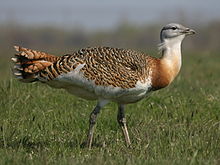| Great bustard | |
|---|---|

| |
| Scientific classification | |
| Domain: | Eukaryota |
| Kingdom: | Animalia |
| Phylum: | Chordata |
| Class: | Aves |
| Order: | Otidiformes |
| Family: | Otididae |
| Genus: | Otis |
| Species: | O. tarda
|
| Binomial name | |
| Otis tarda | |

| |
| Range of Otis tarda Breeding Resident Passage Non-breeding
| |
The great bustard (Otis tarda) is a bird in the bustard family, and the only living member of the genus Otis.[2] It breeds in open grasslands and farmland from northern Morocco, South and Central Europe to temperate Central and East Asia. European populations are mainly resident, but Asian populations migrate farther south in winter. Endangered as of 2023, it had been listed as a Vulnerable species on the IUCN Red List since 1996.[1]
Portugal and Spain now have about 60% of the world's great bustard population.[3] It was driven to extinction in Great Britain, when the last bird was shot in 1832. Since 1998 The Great Bustard Group have helped reintroduce it into England on Salisbury Plain, a British Army training area.[4] Here, the lack of public access and disturbance allows them the seclusion they desire as a large, ground-nesting bird.
- ^ a b c BirdLife International (2023). "Otis tarda". IUCN Red List of Threatened Species. 2023: e.T22691900A226280431. Retrieved 12 December 2023.
- ^ Gill, Frank; Donsker, David; Rasmussen, Pamela, eds. (2023). "Turacos, bustards, cuckoos, mesites, sandgrouse". World Bird List. 13.1. International Ornithologists' Union. Retrieved 12 December 2023.
- ^ Cite error: The named reference
HBWwas invoked but never defined (see the help page). - ^ "Reintroducing the great bustard to Southern England". RSPB. Retrieved 2015-12-26.
